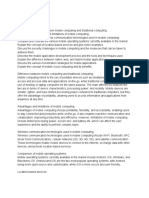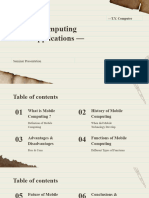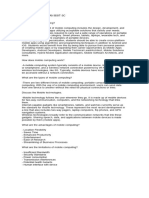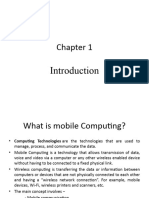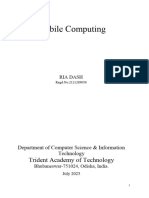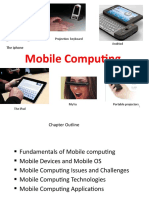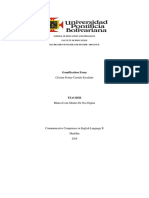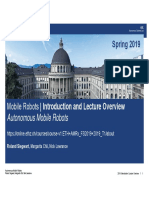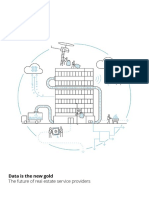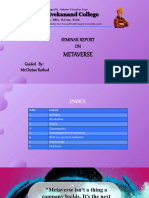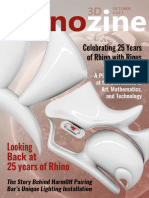1. Discuss the impact of mobile computing on modern society.
Provide examples
of how mobile computing has transformed various industries.
Mobile computing has had a transformative impact on modern society, influencing various facets
of daily life and numerous industries including;
i. Communication- Mobile devices have revolutionized the way we communicate. Instant
messaging apps like WhatsApp, Telegram, and Signal offer real-time text, voice, and
video communication. Social media platforms such as Facebook, Instagram, and Twitter
have become primary means for people to connect and share information globally. Video
conferencing tools like Zoom, Microsoft Teams, and Google Meet have facilitated virtual
meetings, especially crucial during the COVID-19 pandemic.
ii. Commerce- Mobile commerce (m-commerce) has transformed shopping behaviors.
Platforms like Amazon, eBay, and Alibaba have robust mobile apps that allow users to
browse, purchase, and track orders seamlessly. Mobile payment solutions such as Apple
Pay, Google Wallet, and Samsung Pay, along with digital wallets like PayPal and
Venmo, enable quick and secure transactions both online and in physical stores.
iii. Healthcare- Mobile computing in healthcare has led to significant advancements.
Telemedicine apps like Teladoc and Doctor on Demand allow patients to consult with
healthcare professionals remotely. Health tracking apps and wearable devices such as
Fitbit, Apple Watch, and various smartphone health apps help users monitor their
physical activity, heart rate, sleep patterns, and more, providing valuable data for both
users and healthcare providers.
iv. Education- The rise of e-learning and mobile learning platforms has democratized access
to education. Apps like Khan Academy, Coursera, and Duolingo offer a wide range of
courses and learning materials accessible from anywhere. Educational institutions use
platforms like Google Classroom and Blackboard to facilitate remote learning, making
education more flexible and inclusive.
v. Entertainment- The entertainment industry has shifted towards mobile consumption.
Streaming services like Netflix, Hulu, and Disney+ offer a vast array of content
accessible on mobile devices. Social media platforms, including YouTube and TikTok,
have become major sources of entertainment, while mobile gaming has surged in
popularity with games like PUBG Mobile, Fortnite, and Candy Crush Saga.
vi. Transportation- Mobile computing has improved transportation efficiency. Ride-hailing
services like Uber and Lyft provide convenient and cost-effective transportation options.
Navigation apps like Google Maps, Waze, and Apple Maps offer real-time traffic
updates, route optimization, and location-based services, making travel more efficient.
Transformation of Various Industries
i. Retail- The retail industry has adapted to the mobile era by developing apps that offer
personalized shopping experiences, loyalty programs, and mobile payment options.
Augmented reality (AR) apps allow users to visualize products in their environment
before making a purchase, enhancing the shopping experience.
ii. Finance- Mobile banking and financial services apps have revolutionized the way people
manage their finances. Apps like Chase, Bank of America, and Mint allow users to
� perform banking transactions, track expenses, and manage investments from their
phones. Fintech companies like Robinhood and Acorns provide innovative investment
solutions through mobile platforms.
iii. Healthcare- Mobile health apps and telemedicine platforms have made healthcare more
accessible. Apps like MyChart and HealthTap allow patients to access their medical
records, schedule appointments, and receive medical advice. Wearable devices and
mobile apps track health metrics, enabling proactive health management and early
detection of potential health issues.
iv. Education- Mobile platforms have facilitated remote learning and expanded educational
opportunities. Apps like Quizlet and Kahoot! offer interactive learning tools, while
platforms like Zoom and Google Meet enable virtual classrooms and collaborative
learning. Mobile technology has made education more accessible to students in remote or
underserved areas.
v. Transportation- Mobile apps have improved public and private transportation. Ride-
hailing apps provide convenient transportation options, while apps like Moovit and
Transit offer real-time public transit information. Car-sharing services like Zipcar and
bike-sharing programs can be easily accessed through mobile apps, promoting
sustainable transportation options.
2. Compare and contrast the Android and iOS mobile operating systems in
terms of user interface, security, and app development ecosystem.
Feature Android iOS
User Interface
Customization High level of customization with Limited customization, emphasizing
themes, launchers, and widgets consistency and ease of use
Diverse Open nature allows manufacturers to Uniform design language across all
Interface implement their own UIs, leading to devices for a cohesive experience
varied experiences
Security
Open Source Greater customization but higher Closed ecosystem with robust
vulnerability to malware and breaches; security features; stringent app
mitigated by Google Play Protect and review process and regular updates
regular updates
Fragmentation Diverse devices lead to fragmented Controlled environment ensures
security updates, leaving some devices timely updates and consistent
potentially vulnerable security standards across all devices
Advanced Some devices offer features like Advanced security features like Face
Security fingerprint sensors and facial ID, Touch ID, and end-to-end
Features recognition, but implementations vary encryption
by manufacturer
� App Development Ecosystem
Flexibility Open ecosystem allows for greater Controlled environment with rigorous
freedom in app design and app review process, ensuring high
distribution, resulting in a diverse quality and security standards
range of apps
Lower Easier to publish apps on the Google Higher barrier to entry, but known for
Barrier to Play Store, leading to a higher number lucrative opportunities for developers
Entry of apps but also more low-quality or due to higher user spending on apps and
malicious apps in-app purchases
Lucrative Diverse range of apps but generally Known for lucrative opportunities for
Market lower revenue per user compared to developers, with users tending to spend
iOS more on apps and in-app purchases
3. Explain the importance of power management in mobile devices and describe
various techniques used to extend battery life.
Explain the importance of power management in mobile devices
i. Prolonging Battery Life
Mobile devices rely on battery power, and efficient power management helps extend the time
between charges. By optimizing how energy is consumed, users can enjoy longer use of their
devices without needing to recharge frequently. This is particularly important for users who rely
heavily on their devices throughout the day for work, communication, and entertainment.
ii. Enhancing User Experience
A device that frequently runs out of battery can be frustrating for users. Good power
management ensures that essential functions like calls, messages, and internet browsing can be
performed reliably. By managing power efficiently, devices can offer consistent performance,
reducing instances where users need to conserve battery or search for a charger.
iii. Improving Device Longevity
Battery lifespan diminishes over time due to charging cycles and energy consumption patterns.
Effective power management reduces the strain on the battery, potentially extending its overall
lifespan. This means that users do not need to replace their devices or batteries as often, resulting
in cost savings and reduced electronic waste.
iv. Supporting Advanced Features
Modern mobile devices come with a plethora of advanced features, such as high-resolution
displays, powerful processors, and various sensors. These features consume significant power.
Effective power management ensures that these features can be utilized without draining the
battery excessively, maintaining the balance between functionality and power consumption.
� v. Environmental Impact
Efficient power management contributes to energy conservation. Lower power consumption
translates to fewer charges, reducing the overall energy footprint of the device. This can
contribute to broader efforts in energy efficiency and environmental sustainability.
Techniques to Extend Battery Life
i. Optimized Hardware Components
a. Energy-Efficient Processors: Using processors with lower power
consumption, such as ARM-based CPUs, helps reduce battery drain.
b. Displays: OLED and AMOLED screens consume less power than traditional
LCDs, especially when displaying dark themes or black backgrounds.
ii. Software Optimization
a. Resource Management: Mobile operating systems manage resources
efficiently by prioritizing tasks and minimizing background activity. Techniques
include limiting background processes and optimizing app behavior to reduce
power usage.
b. App Sleep Modes: Putting unused apps to sleep or limiting their background
activity conserves battery life.
iii. Battery-Saving Modes
a. Power-Saving Modes: Most mobile devices offer power-saving modes that
reduce performance, limit background activity, and disable non-essential
features to extend battery life during low-power situations.
b. Ultra Power-Saving Modes: Some devices have ultra power-saving modes that
significantly restrict functionality to preserve battery life for critical use.
iv. Adaptive Brightness and Screen Management
a. Automatic Brightness Adjustment: Adjusting screen brightness based on
ambient light conditions helps conserve battery power.
b. Screen Timeout: Reducing the screen timeout duration ensures the display
turns off quickly when not in use, saving power.
v. Network Management
a. Efficient Connectivity: Managing how and when the device connects to
networks (Wi-Fi, cellular, Bluetooth) can reduce power drain. For example,
switching to Wi-Fi when available is more energy-efficient than using cellular
data.
b. Airplane Mode: Enabling airplane mode when connectivity is not needed can
save significant battery life by turning off all wireless radios.
vi. Efficient App Design
a. Minimizing Background Activity: Developers can design apps to use less
power by minimizing background activity and optimizing code for performance.
b. Wake Locks: Avoiding unnecessary wake locks, which keep the device active,
helps conserve battery life.
BT GICHERU DUNCAN 21/05493


